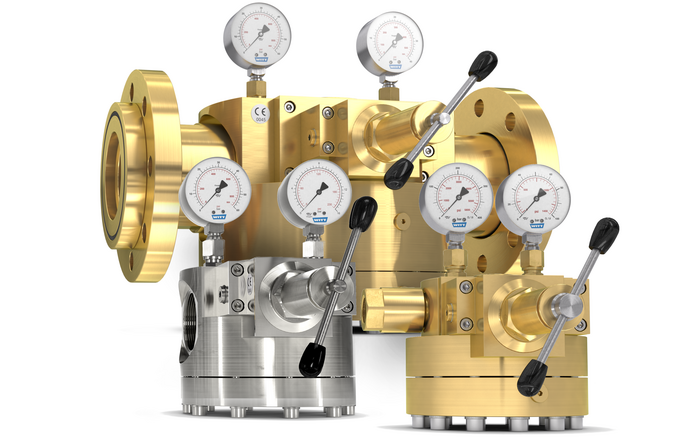Mr Smart, why are you focused on dome pressure regulators?
Dome pressure regulators simply provide more performance: They control the gas pressure extremely well at a constant value. Fluctuating inlet pressures or variation in flow rates quantities are no problem with good dome pressure regulators. The working pressure always stays the same. In many applications this gives our customers a clear benefit.
Dome pressure regulators are therefore better than the spring-loaded types?
That depends: If I have a constant inlet pressure and always the same flow rate quantity, I can probably get by with a conventional pressure regulator. If there are changes in consumption or fluctuations on the supply side, a dome pressure regulator is clearly the better choice. Although there are also large differences there. I always say: There are dome pressure regulators and there are Witt dome pressure regulators.
How does a dome-loaded pressure regulator work exactly?
Generally, a force is needed for setting the pressure in any pressure regulator. This is supplied by simple helical steel springs in conventional types. The force set for the spring supplies the counterforce to reduce the actual gas pressure to the desired working pressure. In dome pressure regulators, the required counterforce is supplied by gas pressure. The regulating gas forms a sort of gas cushion and presses on a diaphragm whose movement is transferred to the valve seat. The valve is therefore opened by the pressure of the regulating gas and feeds the exact, required quantity of gas to be regulated. This is because the outlet pressure behind the valve seat acts on the diaphragm as a counterbalance to the regulating pressure. Regulating pressure and working pressure therefore hold the regulator in ‘balance’ and the working pressure constant.
Where does the regulating gas come from?
Simple models work with encapsulated control gas in a ‘dome’ above the diaphragm, hence the name dome. Changing the working pressure is quite complex. As a rule, an additional regulating pressure controller is used. The user sets the pressure at the dome pressure regulator via the pilot pressure controller and so controls the required working pressure.
And what does Witt do that is different from the others?
Firstly, we have integrated the pilot pressure and dome pressure regulators into a single valve. We supply an orientation-independent complete solution including pressure gauges. The regulator is fully assembled and ready for immediate use. This means very low installation and maintenance costs. Incidentally, operation with an electrical proportional valve is also possible as an alternative to the pilot pressure regulator. This is key if the dome pressure regulators are being driven by an external control system.
But there are even more differences?
Exactly. For example, we measure the working pressure via the so-called “Pilot Control Tube” at the output of the pressure regulator and not at the valve seat. In other words, precisely at the point relevant for a correct working pressure regulation. Or take our “Balance Seat Design”; here the valve seat gets balanced from both sides by the back pressure. Upstream pressure fluctuations have no effect on the regulator. Further difference: Unlike many other dome designs, the diaphragms of WITT domes are not located directly on the valve seat. Instead, their movement is transferred via a special diaphragm plate. This enables a very precise pressure regulation.
How are the differences apparent to the user?
Look at the pressure curve versus increasing flow rate. That is very impressive. With other dome pressure regulators, this curve falls off as a rule; that means the more gas extracted the lower is the available pressure. Our curve stands out as a straight line, practically unchanged over the entire possible flow range. No readjustment is necessary. Witt dome pressure regulators also react extraordinarily quickly to changes in upstream pressure. So outlet pressure fluctuations and fluttering, simply do not occur. Here we differ from the others in the market. As a last feature, I would also mention the lower pressure drop in our regulators. We can control exactly, even at a pressure difference of only one bar between upstream and downstream pressures.
Can you give typical examples of applications using dome pressure regulators?
Gladly: Our regulators are used, for example, for CO2 systems providing welding gases. This is about coping with big fluctuations in consumption, based on how many user points are in operation at any one the time. The working pressure remains stable with Witt dome pressure regulators. The domes are also often used for industrial gas supplies at high pressure, for example downstream of a tube-trailer, tank or cylinder bundle. The low pressure loss of the regulator enables maximum emptying of the vessel, so reducing logistic costs. But dome pressure regulators are also suited to gas supply for food applications or nitrogen purge gas supply in the chemical industry.
They are also built into machines, e.g. for correct gas dosing to flame cutting machines. The control here uses electrical proportional valves. And a definite speciality is their use on the outlets cryogenic tank vaporisers.
What is the special feature there?
A cryogenic tank is used in this application as a back-up supply for gas generators, to ensure 24-hour availability. The high precision of Witt regulators enables the immediate response of the cryogenic supply when the generator’s performance drops off. The mechanical solution from Witt replaces previous standard solutions that consisted of a complex and costly arrangement of pressure transmitters, pressure control valves, alarm modules and other components. This is real “Value Engineering” for the user.



